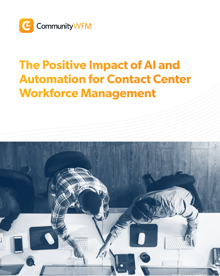
Being strategic about contact center workforce management (WFM) has never been more important. Agents have evolving demands and companies are constantly looking to modern technology in order to keep up. At the same time, reducing overhead costs and staying within budget also remains a top priority.
To smartly modernize workforce management processes, more companies are turning to the latest technology trends – including AI, machine learning, and data science – to drive fiscal value and streamline the way they work.
But how do these different areas of technology impact an industry that has been dominated by automation for decades? Below are four ways contact centers are leveraging AI and modern technology to improve workforce management operations.
1) Anomaly detection to improve agent staffing – Wouldn’t it be great if you knew when and how to staff your contact center up or down based on how the day is going? Workforce management software leverages AI to help contact centers answer this question every day. It all ties directly into utilizing anomaly and change detection for commonly monitored metrics such as call volume and average handle time (AHT).
In the past, WFM software was used to build a forecast and schedule in situations where you were often still making some assumptions and hoping for the best. Maybe you have a hunch that weather patterns during a certain time of year affect staffing. But what metrics do you need to evaluate and where should additional staff be allocated? AI can advise on answering these questions through anomaly detection.
Once enabled, AI will review legacy data surrounding important key metrics within your WFM system and alert you about rare scenarios which have occurred in the past. Instead of manually combing through years of information, AI can let a WFM analyst know that on what appears to be a normal Thursday it has detected higher than normal AHT on this day for five consecutive years. The analyst can then consider this information and make quick adjustments both before the day occurs and then also during the day with AI suggestions from an intraday planning report. Coupling together anomaly detection with intraday planning creates a strong AI solution that ensures agent counts and bottom line costs stay aligned.

2) Streamlined predictive forecasting through machine learning – Any WFM analyst, especially those equipped with lackluster technology, will tell you that building a forecast with dated methods is time consuming. However, modern machine learning capabilities are now capable of streamlining the entire forecasting process.
How exactly does this work? Let’s say your contact center needs to build out a forecast every two weeks as the foundation for short-term operations. Traditionally it’s been a lengthy process where your WFM analyst manually pulls recent data around key metrics every time and then looks at historical context to craft a forecast. Instead of repeating this process over and over throughout the year, modern WFM software is evolving and leveraging machine learning to streamline the predictive forecasting process.
Now, the exact same WFM analyst can configure their date parameters in the software and the model formed through machine learning will optimize itself to create the forecast with no manual effort. It’s really using AI to power IA – intelligent automation – where the WFM analyst will be notified instantly when a new forecast has been created by the software. Best of all, through machine learning the forecasting quality will only continue to improve over time as more actionable data is able to be analyzed and considered during the creation process.
3) Adherence reconciliation to improve phone state accuracy – Contact centers can be unpredictable. For example, when call volume spikes because a marketing collaboration does much better than expected, different events including breaks and agent training may need to be postponed. It’s all hands on deck to keep customers happy.
However, sometimes forgotten in the aftermath of these events is the chaos done to the key metrics a WFM analyst keeps an eye on every day. They may know in the moment a large group of agents was out of adherence for an hour… but will their boss know this looking back at the data three months from now? Probably not. It means the analyst either needs to add a disclaimer around inaccuracy to the data or set aside time to fix the adherence for each agent manually. Neither option is really a great choice.
Fortunately, AI capabilities are starting to power much of the work surrounding adherence reconciliation situations like the one mentioned above. By observing staffing trends throughout the day, it’s possible for AI to detect adherence state discrepancies and correct them on behalf of the WFM analyst given the specific scenario that may have occurred. As another example, if agents were supposed to be in training but instead had active phone states, AI can adjust the adherence automatically to reflect the correct work status. It’s a way to eliminate mundane and manual work for a WFM analyst so they can focus on more important initiatives.
4) Leveraging data science for skill based capacity planning – Tracking agent skills isn’t necessarily a new concept to many contact centers. After all, having multiskilled (phone, email, chat) agents available can be hugely beneficial for maintaining and optimizing staffing levels as contact volume fluctuates. Is phone volume currently low? Have a multiskilled agent assist with email support until calls start coming in again later in the day.
However, multiskilled agents can demand higher wages, and of course a good contact center also must factor in agent productivity and preferences. After all, just because an agent can work on emails doesn’t mean they prefer it over chat or phone support. To help with complex skill management in the contact center, companies are now evaluating how data science can facilitate solving their skill based capacity planning needs.
Instead of just scheduling an agent on email because they can work it, modern technology will look at how good the agent is at the skill and if they prefer to work on that channel before taking any further actions. If an agent prefers phone support and ranks highly on the channel but can also work emails at an average level, data science can be utilized to determine if this agent can initially fill an open phone shift. Then, only if all relevant phone hours have been allocated, should the agent be considered for an email shift.
To summarize, AI and modern technology improves workforce management operations by saving time and enabling efficiencies that were not possible even five years ago. Contact centers will discover that leveraging these solutions alongside powerful automation and a knowledgeable WFM analyst drives innovative cost savings and creates a better customer experience through improved agent morale.








